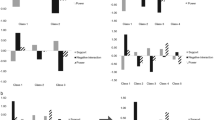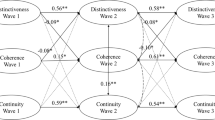Abstract
Erikson’s core stages (trust, identity, and ego integrity) were modeled over 34 years from college through the late 1950s among 175 men and women tested on the Inventory of Psychosocial Development (Constantinople, Dev Psychol 1:357–372, 1969) testing the hypothesis that each, although united by the theme of wholeness and continuity, would show distinct developmental trajectories. Stage 1 (Trust versus Mistrust) followed a positive linear trajectory and Stage 5 (Identity versus Diffusion) followed a curvilinear trajectory that leveled off in middle adulthood. Stage 8 (Ego Integrity versus Despair) followed a curvilinear trajectory with an increasing trend in middle adulthood. The unique trajectories for each of the psychosocial crisis stages were expected on the basis of Erikson’s theory. In addition, there was also significant variability in either the mean or slope of each stage demonstrating individual differences in change, a central tenet of Erikson’s life span developmental approach.



Similar content being viewed by others
References
Alder, A. G., & Scher, S. J. (1994). Using growth curves analyses to assess personality changes and stability in adulthood. In T. F. Heatherton, & J. L. Weinberger (Eds.), Can personality change? (pp. 149–173). Washington, DC: American Psychological Association.
Baltes, P. B., Reese, H. W., & Nesselroade, J. R. (1988). Life span developmental psychology: Introduction to research methods. Hillsdale, NJ: Lawrence Erlbaum Associates.
Charles, S. T., Reynolds, C. A., & Gatz, M. (2001). Age-related differences and change in positive and negative affect over 23 years. Journal of Personality and Social Psychology, 80, 136–151.
Constantinople, A. (1969). An Eriksonian measure of personality development in college students. Developmental Psychology, 1, 357–372.
Costa, P. T., & McCrae, R. R. (1994). Set like plaster? Evidence for the stability of adult personality. In T. F. Heatherton, & J. L. Weinberger (Eds.), Can personality change? (pp. 21–40). Washington, DC: American Psychological Association.
Erikson, E. H. (1963). Childhood and society (2nd ed.). New York: Norton.
Erikson, J. M. (1991). Wisdom and the senses: The way of creativity. New York: W. W. Norton & Company, Inc.
Helson, R., Jones, C., & Kwan, V. S. Y. (2002). Personality change over 40 years of adulthood: Hierarchical linear modeling analyses of two longitudinal samples. Journal of Personality and Social Psychology, 83, 752–766.
Helson, R., & Roberts, B. W. (1994). Ego development and personality change in adulthood. Journal of Personality and Social Psychology, 66, 911–920.
Hox, J. (2002). Multilevel analysis: Techniques and applications. Mahwah, NJ: Lawrence Erlbaum Publishers.
James, W. (1890). Principles of psychology. New York: Holt.
Logan, R. D. (1986). A reconceptualization of Erikson’s theory: The repetition of existential and instrumental themes. Human Development, 29, 125–136.
Mahler, M., Pine, F., & Bergman, A. (1975). The psychological birth of the human infant. New York: Basic Books.
Marcia, J. E. (1994). Ego identity and object relations. In J. M. Masling, & R. F. Bornstein (Eds.), Empirical perspectives on object relations theory (vol. 5). Washington, DC: American Psychological Association.
McAdams, D. P. (1994). Can personality change? Levels of stability and growth in personality across the life span. In T. F. Heatherton, & J. L. Weinberger (Eds.), Can personality change? (pp. 299–313). Washington, DC: American Psychological Association.
Mroczek, D. K., & Spiro, A. (2003). Modeling intraindividual change in personality traits: Findings from the normative aging study. Journal of Gerontology: Psychological Sciences, 58B, P153–P165.
Nesselroade, J. R. (1991). Interindividual differences in intraindividual change. In J. L. Horn (Ed.), Best methods for the analysis of change (pp. 92–105). Washington, DC: American Psychological Association.
Roberts, B. W., & DelVecchio, W. F. (2000). The rank-order consistency of personality traits from childhood to old ages: A quantitative review of longitudinal studies. Psychological Bulletin, 126, 3–25.
Singer, J. D. (1998). Using SAS PROC MIXED to fit multilevel models, hierarchical models, and individual growth models. Journal of Educational and Behavioral Statistics, 24, 323–355.
Singer, J. D., & Willett, J. B. (2003). Applied longitudinal data analysis: Modeling change and event occurrence. NY: Oxford University Press.
Sneed, J. R., & Whitbourne, S. K. (2003). Identity processes and self-consciousness in middle and later adulthood. Journals of Gerontology, 58B, P313–319.
Stephen, J., Fraser, E., & Marcia, J. E. (1992). Moratorium-achievement (Mama) cycles in lifespan identity development: Value orientations and reasoning system correlates. Journal of Adolescence, 15, 283–300.
Waterman, A. S. (1999). Identity, the identity statuses, and identity status development: A contemporary statement. Developmental Review, 19, 591–621.
Whitbourne, S. K. (2008). Adult development and aging: Biopsychosocial perspectives (3rd ed.). NY: John Wiley & Sons, Inc.
Whitbourne, S. K., & Van Manen, K. W. (1996). Age differences in and correlates of identity status from college through middle adulthood. Journal of Adult Development, 3(2), 59–70.
Whitbourne, S. K., & Waterman, A. S. (1979). Psychosocial development during the adult years: Age and cohort comparisons. Developmental Psychology, 15, 373–378.
Whitbourne, S. K., & Willis, S. L. (2006). The baby boomers grow up: Contemporary perspectives on midlife. Mahwah, NJ: Erlbaum.
Whitbourne, S. K., Zuschlag, M. K., Elliot, L. B., & Waterman, A. S. (1992). Psychosocial development in adulthood: A 22-year sequential study. Journal of Personality and Social Psychology, 63, 260–271.
Author information
Authors and Affiliations
Corresponding author
Rights and permissions
About this article
Cite this article
Sneed, J.R., Whitbourne, S.K. & Culang, M.E. Trust, Identity, and Ego Integrity: Modeling Erikson’s Core Stages Over 34 Years. J Adult Dev 13, 148–157 (2006). https://doi.org/10.1007/s10804-007-9026-3
Published:
Issue Date:
DOI: https://doi.org/10.1007/s10804-007-9026-3




